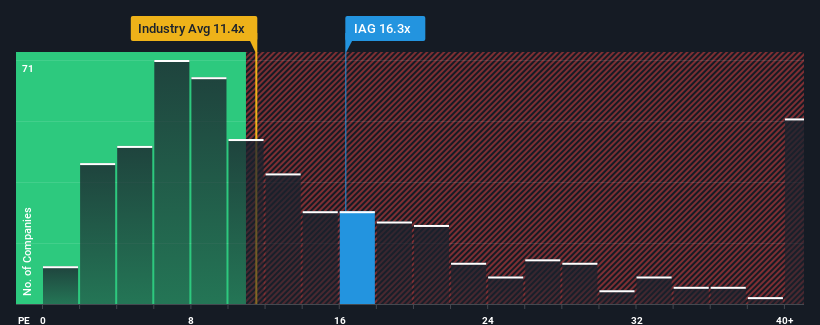There's No Escaping Insurance Australia Group Limited's (ASX:IAG) Muted Earnings

With a price-to-earnings (or "P/E") ratio of 16.3x Insurance Australia Group Limited (ASX:IAG) may be sending bullish signals at the moment, given that almost half of all companies in Australia have P/E ratios greater than 19x and even P/E's higher than 37x are not unusual. However, the P/E might be low for a reason and it requires further investigation to determine if it's justified.
With its earnings growth in positive territory compared to the declining earnings of most other companies, Insurance Australia Group has been doing quite well of late. One possibility is that the P/E is low because investors think the company's earnings are going to fall away like everyone else's soon. If not, then existing shareholders have reason to be quite optimistic about the future direction of the share price.
Check out our latest analysis for Insurance Australia Group

Does Growth Match The Low P/E?
There's an inherent assumption that a company should underperform the market for P/E ratios like Insurance Australia Group's to be considered reasonable.
Taking a look back first, we see that the company grew earnings per share by an impressive 141% last year. Pleasingly, EPS has also lifted 83% in aggregate from three years ago, thanks to the last 12 months of growth. Accordingly, shareholders would have probably welcomed those medium-term rates of earnings growth.
Shifting to the future, estimates from the twelve analysts covering the company suggest earnings should grow by 6.9% per annum over the next three years. With the market predicted to deliver 17% growth each year, the company is positioned for a weaker earnings result.
With this information, we can see why Insurance Australia Group is trading at a P/E lower than the market. It seems most investors are expecting to see limited future growth and are only willing to pay a reduced amount for the stock.
What We Can Learn From Insurance Australia Group's P/E?
Typically, we'd caution against reading too much into price-to-earnings ratios when settling on investment decisions, though it can reveal plenty about what other market participants think about the company.
As we suspected, our examination of Insurance Australia Group's analyst forecasts revealed that its inferior earnings outlook is contributing to its low P/E. At this stage investors feel the potential for an improvement in earnings isn't great enough to justify a higher P/E ratio. It's hard to see the share price rising strongly in the near future under these circumstances.
A lot of potential risks can sit within a company's balance sheet. Take a look at our free balance sheet analysis for Insurance Australia Group with six simple checks on some of these key factors.
If these risks are making you reconsider your opinion on Insurance Australia Group, explore our interactive list of high quality stocks to get an idea of what else is out there.
New: AI Stock Screener & Alerts
Our new AI Stock Screener scans the market every day to uncover opportunities.
• Dividend Powerhouses (3%+ Yield)
• Undervalued Small Caps with Insider Buying
• High growth Tech and AI Companies
Or build your own from over 50 metrics.
Have feedback on this article? Concerned about the content? Get in touch with us directly. Alternatively, email editorial-team (at) simplywallst.com.
This article by Simply Wall St is general in nature. We provide commentary based on historical data and analyst forecasts only using an unbiased methodology and our articles are not intended to be financial advice. It does not constitute a recommendation to buy or sell any stock, and does not take account of your objectives, or your financial situation. We aim to bring you long-term focused analysis driven by fundamental data. Note that our analysis may not factor in the latest price-sensitive company announcements or qualitative material. Simply Wall St has no position in any stocks mentioned.
About ASX:IAG
Insurance Australia Group
Insurance Australia Group Limited underwrites general insurance products and provides investment management services in Australia and New Zealand.
Good value with adequate balance sheet.


